Tech Trailblazers: Breaking the Glass Ceiling
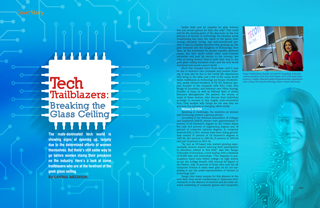
The male-dominated tech world is showing signs of opening up, largely due to the determined efforts of women themselves. But there’s still some way to go before women stamp their presence on the industry. Here’s a look at some trailblazers who are at the forefront of the geek glass ceiling.
Barbie dolls and art supplies for girls. Science kits and arcade games for boys. But why? That could well be the starting point of the discourse on the low presence of women in technology. For decades, social conditioning has been the name of the game, even among educated, loving, and well-intentioned parents. It was no surprise therefore that growing up, few girls ventured into the Kingdom of Technology. Over time, as the movement for gender equality gathered steam, the tech world joined other male-oriented industries and paid lip service to the concept. But even as young women tried to push their way in, the geek glass ceiling remained intact and the tech world remained very much a man’s world.
Much has changed since those days—and it may be due to women’s own chutzpah and creative thinking. It may also be due to the varied life experiences they bring to the table. Just a few of the many South Asian trailblazers in technology are Roopa Unnikrishnan, newly elected President of TiE NY, Reshma Saujani, founder of the nonprofit Girls Who Code, Ritu Banga of Zoomdojo, and Atlanta’s own Vibha Rustagi, founder of itaas, as well as Naheed Syed of Global Resource Management. We present the stories of some of these women, who discuss their individual journeys to success in this hugely male-dominated field. They analyze why things are the way they are and how the scenario is changing, albeit slowly.
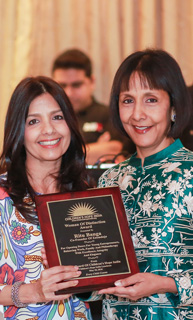
Ritu Banga (right), Cofounder of Zoomdojo, a tech startup with a database of 60,000 jobs and internships.
Women in STEM
Speaking of challenges, the statistics on women and technology present a gloomy picture.
According to the National Association of Colleges and Employers (NACE), women earn approximately 57 percent of all bachelor’s degrees in the United States but only 18.4 percent of engineering degrees and 18 percent of computer sciences degrees. In computer sciences (CS), in fact, women have been losing ground: they earned 37 percent of CS bachelor’s degrees in 1983-84, 28.5 percent in 1993-94, 25 percent in 2003-04 and just 18 percent in 2013-14.
“So just as CS-based jobs started growing exponentially, women started reducing their participation in education related to this field,” says Ritu Banga, Cofounder of Zoomdojo, a tech startup with a database of 60,000 jobs and internships. “The disparity in participation starts even before college—in high school, as per the College Board’s 10th Annual AP Report to the Nation, only 19 percent of those who took the AP Computer Science A exam were girls. So it’s not surprising to see the underrepresentation of women in technology jobs.”
Banga cites many reasons for this absence in the tech field, from social conditioning to classroom environments, to the absence of mentors and the male-oriented marketing of computer games and computers. “Perhaps most important is the disparity in pay between similarly qualified male and women CS graduates once they enter the workforce,” she adds. “Out of college, the same NACE study shows that the average starting salary offer is 22 percent less for women CS bachelor’s degree holders than it is for men. I believe that the lower representation of women in technology is a combination of all these factors.”
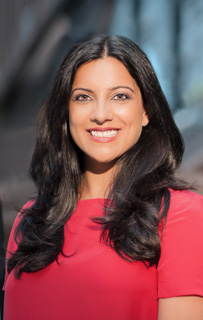
(Right) Reshma Saujani, founder of the nonprofit Girls Who Code.
Reshma Saujani is founder of the nonprofit group ‘Girls Who Code,’ which is trying to change the tide on these dismal figures. She quotes some startling figures: By 2020, there will be 1.4 million jobs available in computing related fields, and US graduates are on track to fill 29 percent of those jobs—but women will fill a mere 3 percent of them.
Silicon Valley Bank’s recent “U.S. Startup Outlook 2016” report found that 66 percent of startups have no women on their boards, and 46 percent have no women in executive positions. An article in Newsweek titled “What Silicon Valley Thinks of Women” addressed this problem and noted, “This matters for tens of thousands of reasons, but on the broadest level, since digital technology is our era’s Industrial Revolution, fortunes being made now and business models and corporate cultures forming today will be with us for a century to come—and women are for the most part sidelined. Zuckerberg, Gates, Thiel, Musk—these are our Carnegies and Morgans and Rockefellers, whose names will be on museum wings and university halls 100 years from now. And there’s not a female among them.”
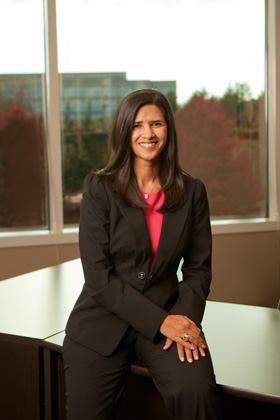
Vibha Rustagi, CEO of itaas, an Atlanta company which she cofounded and sold to Cognizant Technology.
Asked why it’s taken so long for women to break into technology, Vibha Rustagi, CEO of itaas, an Atlanta company which she cofounded and sold to Cognizant Technology, says, “I believe this stems from a fundamental bias on how girls are typically raised and encouraged to follow ‘traditional’ careers for women. It starts at a young age where there are fewer girls in math and science classes. Even though there is lot of talk about encouraging our daughters to study math and science, the statistics prove otherwise.”
She points out that while women receive over half of bachelor’s degrees awarded in the biological sciences, they receive far fewer in the computer sciences (18.2 percent), engineering (19.2 percent), physics (19.1 percent), and mathematics and statistics (43.1 percent) (Source: NSF, Women, Minorities, and Persons with Disabilities in Science and Engineering, 2015).
“In speaking to the woman engineers at my alma mater (University of Pittsburgh) I found little had changed in the percentage of graduating female engineers over the course of 20 years,” says Rustagi. “This means fewer women in technology, and even less in the C-suite of technology companies. So there are fewer role models in the workplace that women can look up to, compared to our male counterparts. There is much press about equality, but we still have much work to do on a social, educational, and corporate level.”
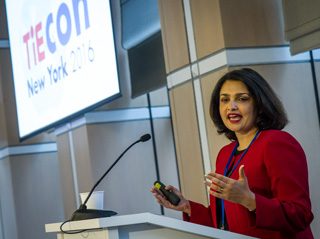
(Right) Roopa Unnikrishnan, founder of Center10 Consulting, is the first woman president of the New York chapter of TiE (The Indus Entrepreneur), a highly influential global entrepreneurship organization with a heavy tilt towards technology. (Photo: Preston Merchant)
Changing Times
Amidst all the gloom and doom, there are glowing
sparks of hope, too. Karen Robinson Cope became
the first female President of the Atlanta Chapter of TiE,
The Indus Entrepreneurs, one of the most influential
entrepreneurship organizations in the world, in
2014. Recently Indian-American women in technology
reached another
marker,
when TiE’s New
York chapter
elected Roopa
Unnikrishnan,
founder of Center10
Consulting,
as its first
woman president.
These may
be the harbingers
of more successes
to come for women in technology. At the recent
NY TiE convention, there were several big names
and innovators, both men and women.
Ask Unnikrishnan why it’s taken so long for women to break into technology, and she turns the question on its head. “I’m not sure that it’s that we haven’t broken into technology. It’s that we were and are just not allowed to take credit for our work. There’s an upcoming movie called Hidden Figures, about Katherine Johnson, the African-American woman who earned the nickname ‘the Human Computer’ at NASA during its space race golden age. It talks about the many times she had to fight to just be in the room.”
She continues, “It’s the hazing technique. I’ve been in rooms where I’ve felt like a pariah, such as one I went to a couple of years ago for a consulting firm alumni event. There were a lot of men, few who felt they could talk to me. My response? Always bring a friend—preferably a talented female exec you know will be fascinating to talk to even if the room ostracizes you!”
The Boys Club
As she points out, in these changing times even as
there are more people who are supportive of talented
women, high-tech companies are among those industries that set up systems around a highly male view of the world, in which all networking happens after work—when many female executives would like to be having dinner with the family and helping the kids with homework. Power negotiations still
happen around golf or on the
squash courts—and certainly over drinks in the old boys’ network!
Asks Unnikrishnan wistfully, “Wouldn’t it be great if we could work around lunch—or make deals at spa weekends?”
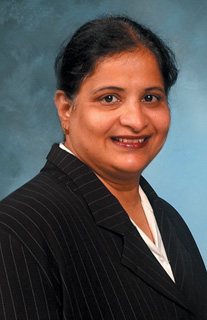
Naheed Syed, whose company Global Resource Management was listed as the sixth largest woman-owned company in Atlanta.
Naheed Syed, whose company Global Resource Management was listed as the sixth largest woman-owned company in Atlanta, belongs to the group of pioneering women who have made their mark in the technology sector. She points out that there are several factors that have impaired women, including the lack of educational opportunities and emphasis on a STEM (science, technology, engineering, and math) background; most young girls haven’t been encouraged to participate in STEM programs during middle/high school within fields such as Engineering and Technology. She says, “Now there is a significant focus on STEM for both males and females. Historically and even currently, the belief is that women are not hardwired to think logically, but recent studies found that girls outperform boys on STEM and in coding skills.”
She also rightly points out that technical jobs do not nurture a work environment that supports a work-life balance, are more stressful, and require longer or adjunct work hours. She addresses another myth: “Women workers are thought to be more emotional than men which may impact their leadership, judgment, and technical problem-solving skills. Women face an unconscious bias, stereotyping, and more difficulty to advance in mid-level and leadership positions than their male counterparts.”
Challenges for South Asian Women
Asked if this was the case with all women or
particularly South Asian women, Syed says, “This is the case for all women, but it is more difficult for South Asian women as their culture requires a higher level of dedication and commitment towards their
immediate and extended families. Also, the male-dominated work
environments make it harder for married women to work in stressful fields with longer and unpredictable hours.”
Women like Ritu Banga, Vibha Rustagi, and Naheed Syed have helped make a difference in the perception of South Asian women in the tech field and have certainly paid their dues in creating a more level playing field. Says Syed, “There has been a very recent breakthrough for South Asian women in the technology area—in spite of these cultural obligations. I’ve personally witnessed the uptick of Indian and South Asian women in various technology roles in recent years, and the positive impact their leadership and contributions have brought to both projects and business support.”
Ritu Banga and her cofounder Carol Rattray have the distinction of creating a tech startup without themselves being in the technology field. Zoomdojo is the go-to place for online and in-person pro bono career counseling programs with colleges and high schools as well as large campus organizations.
It’s All about the Family
Most of these high achieving women say their
parents, with no knowledge of technology themselves, set them on their trajectory to success, with a ‘no-boundaries’ mindset. Banga recalls graduating from Lady Shri Ram College, New Delhi, in 1979 and setting off to do her MBA at the Indian Institute of Management in Ahmedabad.
“It was not the norm for young women to do an MBA at the time—we were just 10 girls in a class of 160 or so … and definitely not the norm to go so far away from home—36 hours by train with no communication other than a telegram to say I had reached. So I am always amazed by my parents’ chutzpah in letting me run with this opportunity.
“These experiences have taught me to be adaptable, to be comfortable with ambiguity. They taught me to always keep learning and exploring, to build support systems from the ground up. And always, always, always to find opportunities to create partnerships and work in collaboration with others.”
Naheed Syed recalls that her mother was the first Senior Cambridge honor student from her school and hometown in India, and this had a huge impact on her. She was also encouraged to participate and win in nontraditional activities like math competitions and science fairs. “I strongly feel that even though technology was not as prominent in the old days, Indian women played a big part in making their daughters competitive and better at STEM education.” In fact these early successes helped her gain confidence and she became a “bank VP before I was 25 in an industry dominated by white males.”
Roopa Unnikrishan—a Rhodes Scholar and an Arjuna Award winner in rifle shooting—also has an inspiring mom story to tell. “My mother was pregnant with me when she won a state medal in shooting… enough said, right? But beyond that, she was one of the people who helped me choose my activities and optional classes, and I remember her saying … “Well, I don’t know what this programming in BASIC is, but why not try it?” So there I was, 30 years ago, getting to play with computers when they were the rarest commodity in the world.” Her father also showed her the possibilities; he opened up the encyclopedia to the name ‘Cecil Rhodes’ when she was 13 and introduced the idea of the Rhodes scholarships to her—and 8 years later, she went on to become a Rhodes Scholar. She recalls, “He took me out to try my hand at all kinds of sporting activities—and there I was winning medals for India in rifle shooting—not a ‘normal’ sport for a young south Indian girl.”
Getting a Foot in the Door
Yet even if these women received encouragement
at home, entering the startup world and looking for
funding is one of the hardest things for women. “Access
to capital is the number one challenge for women in
business—they receive less than 1 percent of venture
capital financing,” says Naheed Syed. “There is a hesitation
in the venture capital industry when it comes
to someone who does not fit the desirable profile. To
overcome this obstacle, women should first share their
credentials and qualifications before the investors become
aware of their looks and their gender.”
Vibha Rustagi and her cofounders launched itaas without any external funding but did build strong relationships with financial institutions and VCs. She says, “During this process, I found the VCs and financial institutions were most concerned about the business case, management experience, and customer commitments, rather than gender roles. This does not mean that biases towards women entrepreneurs are nonexistent, but I did not experience that.” She adds that there are very few women in the venture capital market, and it is harder for women, even today, to find key roles in this space.
For Young Women in Tech, Out of the Box Is
the Mantra
Weaned on ideas of equality and unlimited possibilities,
the younger generation of women is creating
their own scenarios. As Roopa Unnikrishnan says, “In
the startup world, it’s also about making it easier for
investors to see that services that are ‘female’ oriented
are just as viable and have revenue upsides. Don’t discount
them because they aren’t catering to that ‘magic
demographic’ (10-38 year old men). Funding those
ideas will often mean funding female technologists
and entrepreneurs—a step in the right direction.”

Leila Janah (Right), founder of Sama, a social enterprise that helps the poorest of the poor get technology jobs with its clients like Google, Microsoft, TripAdvisor, and Walmart.
Sama, a California-based company started back in 2008 by Leila Janah shows the out-of-the-box, almost disruptive thinking that can revolutionize businesses. The idea behind Sama is audacious—that the poor are capable of doing good work when they are entrusted with it, rather than just being given handouts and pity. This nonprofit trains the poorest of the poor and gets them into technology jobs—it has clients like Google, Microsoft, TripAdvisor, and Walmart. Over 7,000 low-income people have been employed in countries like Haiti, Kenya, Uganda, and India. Besides Sama, Janah is also the Founder and CEO of LXMI, a social impact luxury brand that brings humanity to the beauty business. Both her companies were recognized on Fast Company’s 2016 Most Innovative Companies list that share a common social mission to end global poverty by giving work to people in need. Indeed, given a chance, women can bring life-changing ideas to the technology field.

Payal Kadakia (Left), CEO of ClassPass, a fitness-industry juggernaut. (Photo: courtesy of ClassPass)
Two examples of startups which have a strong woman angle are ClassPass and THINX. In the space of two years, Payal Kadakia, CEO and founder of ClassPass, has built the app- and web-based service into a fitness-industry juggernaut that, for $99 a month, helps adrenaline seekers mix up their routines—and studios fill up spots that would have otherwise gone unused. By the end of this year, it will be in every major U.S. market and 10,000 locations; so far, users have booked more than 2 million classes through the service.
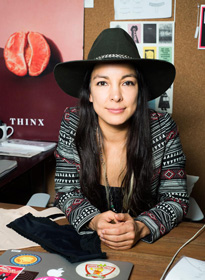
(Right) Miki Agrawal, CEO of THINX, a high-tech underwear.
Miki Agrawal is the New York-based CEO and Cofounder of THINX, a high‐tech underwear solution for women to wear during their periods. She teamed up with AFRIpads in Uganda to fund a pack of reusable cloth pads for every underwear sold to get millions of girls back in school. This is something only a woman would have thought of and with the greater good attached to it.
The Influencers
How does one get to change the atmosphere in the places where decisions are made? How does Unnikrishnan hope to change the situation during her tenure at TiE? After all, she has the bully pulpit. She says, “It’s about strengthening the entrepreneurial environment, providing entrepreneurs mentoring, funding, incubation support, education, and networking opportunities. That’s what made TiE a true engine for innovation in the Silicon Valley ecosystem.”
She is looking to make TiE NY be just as vital a part of the ecosystem as the TiE in the Valley, with partnerships with the government, incubators, supercharging the TiE Angel network, creating innovative ways to draw in mentors for the startups that TiE helps incubate. Making women and other diverse members of society a part of this inner circle is one of the goals. As she points out, the true hope lies with the younger generation which seems more assertive and attuned to the concepts of equality.
She says, “They are great about keeping the conversation bias-free, whether around gender, race, or sexual orientation. Our job will be to try and keep out of their heads as much as we can. Let’s not implant our biases there. Specifically, I am seeing strong men taking a stand. Just saw a Linkedin profile change pop up—‘Diaper Ninja’ it said, of a young man who was taking paternity leave to be with his newborn.”
Indeed, influencers are also emphasizing the importance of equality in the tech sphere. Sree Sreenivasan, media guru, (who is married to Roopa Unnikrishnan) has been highlighting the absence of women in tech panels and has taken a principled stand on not participating on all-male panels. It all started with promising his young daughter that he would not speak on all-male panels and went on to not even attending all-male panels. This has led to quite an awareness movement in social media, and, as he points out, “While I am flattered being one of the faces of the anti-all-male-panel movement, it’s worth pointing out that women, including my wife, Roopa Unnikrishnan, have been raising this issue for years now and it took me and other men stepping forward to get serious attention to this issue.”
Sreenivasan, who was earlier the chief digital officer at Columbia University and later at the Metropolitan Museum of Art has just been recruited by Mayor Bill de Blasio to be the Chief Digital Officer of all of New York City. We should be seeing some innovative outreach in New York to build a more inclusive tech world in Silicon Valley.
An Enabling Environment
Ritu Banga, whose Zoomdojo works with students
across the US and on the Internet, says that
girls have to be inducted into computer science while
still in school so they feel confident and empowered.
Colleges have to make women feel confident about
taking CS courses and majors—which means removing
their fears about facing a classroom environment
that excludes them. Also, employers have to commit
that women in CS careers will not face pay
disparity in comparison to equally qualified
men in similar jobs, and that they
will commit to provide mentorship and
sponsorship to their women CS employees
with a strong focus on reducing
gender disparity in the field.
As she says, “It’s not a question of ‘men being willing to widen the space’—but rather of employers understanding that by making 50 percent of the world’s talent unwelcome in this particular space, which is what the gender disparity in pay indicates, they are doing a disservice to the growth of their businesses and to their shareholders. Governments, corporate governance bodies, media, and social influencers have a role to play as well in incentivizing employers to work towards eliminating this disparity.”
Vibha Rustagi says that the onus of ‘equals in technology’ is a complex issue, and begins with encouraging girls in science and technology at a young age and encouraging them to innovate. “Venture funds that support innovation emerging from female students, university alliances with top female execs in technology, and student mentoring, are just a few areas that would help narrow this gap. It is critical for young girls to have role models they can look up to.”
She points out that the media and the press can play a role in this process as well. While there are several shows that highlight female doctors, lawyers, and FBI agents, she says there are “hardly any shows that portray the coolness factor of women in technology.” She adds that young women have to themselves also challenge the status quo and not take no for an answer: “‘I will persist until I succeed’ is a mantra that helped me. It is important to never give up, always keep learning, ask for help, and surround yourself with people who challenge you.”
Girls Who Code, the national nonprofit founded by Saujani, is working hard to close the gender gap in technology—and this is showing results. According to its statistics, the organization, which started in 2012, will have reached more than 40,000 girls and reached every state by the end of 2016. This year it is running 78 summer immersion programs and 1,500 clubs, and 90 percent of its alumnae plan to take a major or minor in computer science.
There’s reason for optimism for the next generation of women in technology. “My children have been a part of my journey in starting, leading, and selling a technology company,” says Rustagi. “They have witnessed the diversity in our workplace, and know that people of all genders and diverse backgrounds offer unique insights and make a person richer in know edge. They have lived through our successes and failures, and have seen the results of perseverance, focus, and teamwork. I hope that they will carry these lessons as they venture into their careers.”
Indeed, the increased presence of women in technology can only strengthen the field. Remember that picture of scientists celebrating India’s Mars Orbiter Mission, known affectionately as MOM? India beat even China in the Mars race and achieved this technological achievement on a shoestring budget. What was remarkable about the Indian command center, though, was the number of women scientists and engineers involved in MOM.
This absolute inclusion and equality should be the nonnegotiable mantra in all our homes, schools, colleges, and workplaces—and that’s when the glass ceiling will start to crack.
Lavina Melwani is a New York-based journalist who writes for several international publications. She blogs at Lassi with Lavina, www.lassiwithlavina.com. Follow @lavinamelwani.
Enjoyed reading Khabar magazine? Subscribe to Khabar and get a full digital copy of this Indian-American community magazine.
blog comments powered by Disqus










